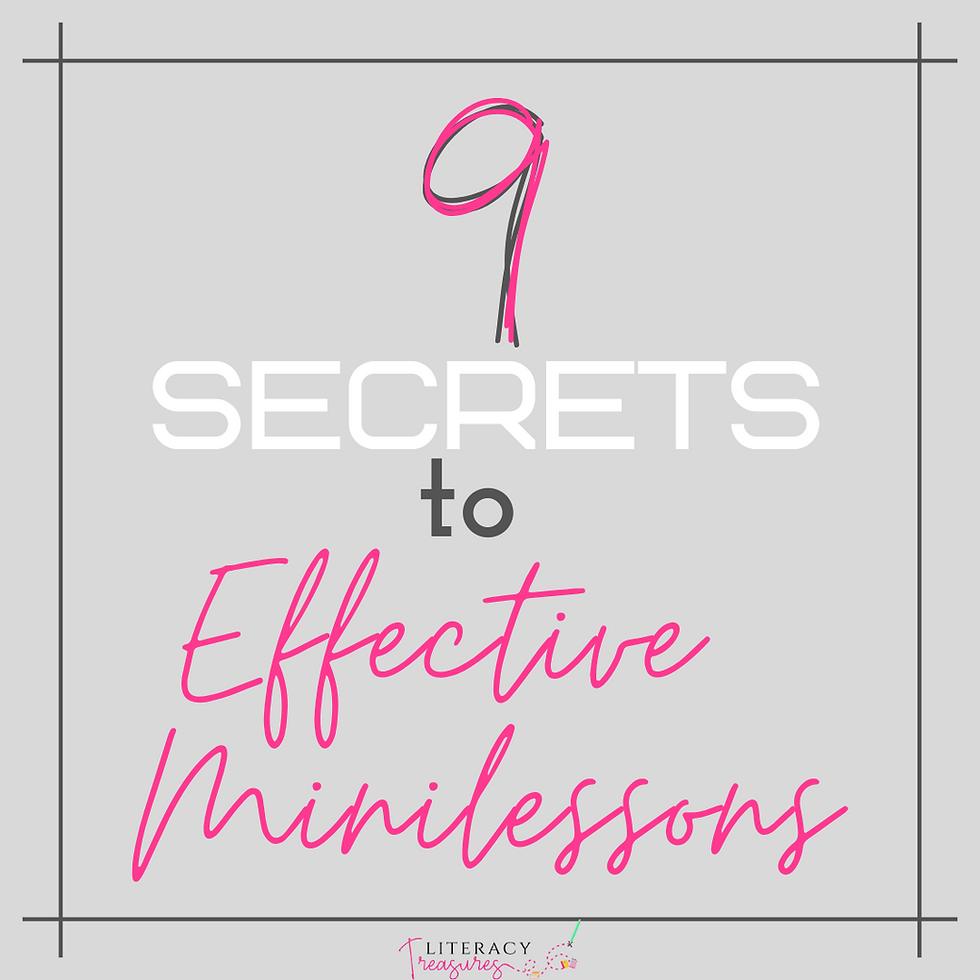9 Secrets to Effective Minilessons
- Tanya
- Jan 16, 2020
- 4 min read
Updated: May 22, 2023

An effective minilesson is short and packed with a powerful message that will ignite and motivate your readers to actively engage in their independent reading work.
Whew! That is an intense and power-packed statement!
9 Secrets to Creating Effective Minilessons

Begin Reader’s Workshop with a minilesson EVERY day
Readers need a predictable schedule in which they know what is expected of them every day for reading.
Making time to engage in a Reading minilesson EVERY day to start Readers’ Workshop is essential! Readers need time to do the authentic work of REAL readers every day!

Design reading minilessons that are intentional, purposeful and well planned
Know your readers!
When you know exactly what your readers need and want, you will be well on your way to planning with intention and minilessons will have a strategic purpose for your students.
Where do you start?
Sift through reading standards to make a list of what readers at your grade level are expected to know by the end of the school year.
Sift through readers’ notebooks or folders of work to see what skills they may be lacking and what pieces of the process your readers are missing.

Make sure the reading minilesson is no longer than 14 minutes
Intentional, purposeful and well-planned minilesson in less than 14 minutes??? It can be done!
Young readers are not proficient readers yet. They need opportunities to practice the overwhelming reading process ONE. PIECE. AT. A. TIME!
Remember the minilesson is just how you KICKSTART the Reading block!
Throughout the reading block, students will be trying out the new learning within their own self-selected texts. How much more intentional and purposeful can you get! 😊
As your readers are independently reading, you will be moving around the room to confer with individual readers and meet with small groups for more intense and differentiated reading instruction.

Use a predictable structure for designing your minilesson
Just as the structure of Readers’ Workshop should be predictable, so should the structure of a minilesson.
There is a certain architecture to the design of an effective minilesson.
First, the new teaching point should be connected to prior learning so readers can see how this new instruction will fit into what they have already learned.
Next…TEACH it! Provide time for readers to see the reading concept, skill or strategy in action!
Then, guide students to actively engage in “having-a-go” at trying the new strategy while you look on.
Finally, before sending them into independent reading, link what they are doing in the minilesson to what is expected of them during independent reading.
Check out my 5 Day Mini-Course for Planning Minilessons for planning effective minilessons! You will gain access to a planning cheat sheet!

Teach ONE thing
This is a hard one! Reading is such a complex process. There are so many moving parts happening all at one time.
BUT…it’s important for young readers to see how each little piece works within their reading.
Then, your readers will begin to piece the proficient reader puzzle together and see how the process works together. THIS. TAKES. TIME!

Use authentic mentor texts to teach the minilesson
Worksheets don’t cut it!
Readers need to see the process in action in an authentic piece of text!
It’s important to find great pieces of text that will help you to display and demonstrate reading strategies and skills for your readers. These authentic texts are then available for students and you to refer to whenever needed.
Authentic texts can be anything from picture books, chunks of texts from a chapter book or novel, articles, short stories or any other piece of text that helps demonstrate a particular skill or strategy. More on using authentic texts in future posts. Stay tuned!

Guide students to actively engage in the reading work
Readers need authentic practice when they are learning a new reading skill or strategy!
Marking letters on a multiple-choice question or answering simple questions on a worksheet just won’t do it!
Authentic means readers need to try out new reading learning within texts that they have chosen based on their own interests and purposes.
Actively engaging in a text may take some guidance for many young readers. This could be nudging conversations among readers, providing guidance or tools to segment a particular strategy or skill. Which brings me to the next secret…

Provide students with literacy tools
When we teach readers one thing at a time, they may need a tool to help segment that particular strategy or skill work within their own independent reading.
Literacy Tools can take on a variety of forms. The purpose of a literacy tool is to engage readers in the strategy or skill work from the minilesson. These tools should be easy to use and readily available.
A literacy tool could be...
a post-it note with thinking stems.
a graphic organizer specifically designed for the skill or strategy.
a visual reminder and explanation of how readers use the particular strategy or skill while reading.

Provide opportunities to practice reading using the literacy tools
Provide multiple opportunities for readers to develop their reading proficiency!
Give students time EVERY DAY to read independently within their own self-selected texts using tools you have provided them within your reading minilessons.
Readers will choose the literacy tool they need at the time they need it!
It’s a common concern among some teachers that a minilesson is not enough time when teaching a reading lesson.
I will stand here all day long and say that it IS the perfect amount of time for teaching readers one new thing to apply to their independent reading.
I had great success with quick minilessons that taught one thing to start Readers’ Workshop.
This instructional decision helped build very successful readers for over 24 years in the classroom.
Until next time,

Check out this Minilesson Planning Cheat Sheet & Guide




Comments